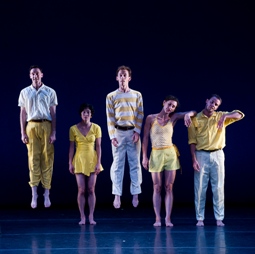JACOB’S PILLOW
Mark Morris Dance Group
Ted Shawn Theatre
August 24-28, 2011
Review by Anna Rogovoy
(BECKET, Mass.) – Mark Morris celebrates his 30th year as Artistic Director of Mark Morris Dance Group this year, an incredible achievement in the world of modern dance. The prolific Morris is the recipient of numerous awards and has created over 130 dance works for MMDG, in addition to commissioned work for other companies. But beyond these and other superlatives is a devotion to music, to pure physicality, and to making dances, as he put it himself, “for the hell of it”.
The first and newest work on the program, Morris’s 2002 Resurrection is a strong introduction to MMDG if only because it gives the dancers of the company leave to do what makes them truly remarkable: relax, have fun, and move together as if they were one being. Sometimes synchronized, sometimes in a canon of motion, their timing is always delectably spot-on, and their awareness of each other hypersensitive. The score, Richard Rodgers’ “Slaughter on Tenth Avenue”, plays up the goofier sections, such as a pantomimed murder, and the dancers appear to revel in the entertaining lightheartedness of the work.
The solo Ten Suggestions, which featured wonderful live piano playing by Colin Fowler, explores play through a series of vignettes. Amber Star Merkens somersaults, hops, and shakes her way through repeated phrases, letting her motions grow bigger each time. As she creates shapes, leaves them, and revisits them in different contexts, we see elements of dancemaking at work. Clad in pink pajamas and with her hair loose, Merkens is reminiscent of a child home from her dance lessons, eager to practice what she has learned. The playfulness of the choreography is tempered by a sort of solemn innocence, a youthful and yet gravely focused concentration not unfamiliar to anyone who has observed a serious young dance student at work.
Dancing Honeymoon borders on absurd. Visually overpowering with bright yellow costumes by Elizabeth Kurtzman and dynamically shifting lighting by Michael Chybowski, it’s a wild romp through classic songs, dance moves, and narratives. The dancers switch from exuberant leaping and bounding to sultry swaggering to whirlwind partnering, accompanied by live music and vocals in a medley of tunes such as “Someone to Watch Over Me,” “And Her Mother Came Too,” and “Goodnight, Vienna”. Morris’s “for the hell of it” attitude is clear here, and we enjoy Honeymoon on a visceral level and little more.
The final work on the program takes us in another direction, a welcome shift at this point from the somewhat relentlessly cheery works before. V, an exploration of pattern and mirroring set to music by Robert Schumann, has little in the way of narrative or character development. Instead, this work focuses on assimilation and juxtaposition, and the ways in which human bodies, as individuals and en masse, fit together and act upon each other to form new images and patterns.
The “V” shape appears many times, and with it implications of complementary and merging forms. The levity of Morris’s choreography is tempered not only by Schumann’s moving piece for piano and strings, but by the presence of something more to consider than schtick or mime. The choreography is still airy and at times jubilant (and no one conveys this jubilance better than Lauren Grant, a longtime MMDG dancer who consistently stands out in a company of standouts), but he delves deeper here, beyond dance for dance’s sake and into what dance has the power to be.


